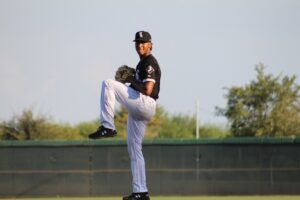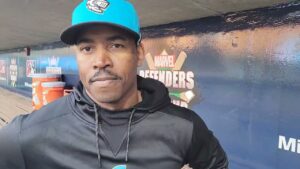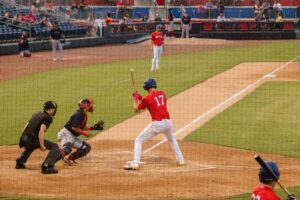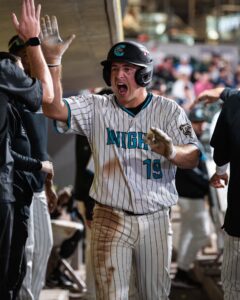Around the League: Catching prospects and the Chicago White Sox
The Chicago White Sox were linked earlier in the offseason to Oakland A’s catcher Sean Murphy, which was a reminder that the catcher position remains at the forefront for serious playoff contenders.
Yasmani Grandal is in the last year of the most expensive contract in White Sox history. Grandal severely underperformed in 2022, and at 34 years old his future with the organization is questionable. Seby Zavala played in 61 games and acted as the teams primary catcher last season down the stretch. If either of the two needs to be replaced due to injury or underperformance, Carlos Perez has developed into a viable backup, although is unproven at the Major League level.
With the aforementioned three players in the fold for the upcoming season, along with several other positions that need to be upgraded, adding a long-term solution at catcher appears to be a luxury the team cannot afford.
Exacerbating the problem is the shortage of catching prospects in the White Sox farm system. After Perez, 2021 18th-round draft pick Adam Hackenberg is the best catcher in the system. Following a torrid start in Kannapolis in 2021, Hackenberg’s numbers trailed off at higher levels of the minors in 2022. He’ll need a couple more seasons for his bat to catch up to his defense before being considered a starting-caliber catcher at the major league level.
Given these circumstances, it appears the White Sox will need to go outside the organization to find their 2024 starting catcher. If the price tag for a current major leaguer is too high, is adding a prospect as part of a larger deal part of the equation? Come along with me as I scour MLB Pipeline’s top catching prospects to find a potential match for the White Sox.
Top Catching Prospects
Francisco Álvarez, New York Mets
MLB Pipeline’s number one overall ranked prospect jumped from Double-A to the majors in 2022, joining the Mets for five games at the tail-end of the season. His prodigious power was on display as he homered in the season’s penultimate game. Given that Alvarez is one of the more appealing offensive prospects in the minor leagues, it’s unlikely the Mets would part with him even if his defensive skills are still developing.
Diego Cartaya, Los Angeles Dodgers
The catcher out of Venezuela is a top 10 prospect MLB Pipeline’s overall rankings. Another power hitter, Cartaya has a well-rounded approach at the plate. He features power to all fields and an ability to work counts. Unlike most offensive-minded catchers, Cartaya shows potential on defense with good hands and a capable throwing arm. Playing most of the season in High-A, the 6’3” backstop is a year or two away from the major leagues.
Although the Dodgers are set behind the plate with Will Smith for the next few years, it’ll be difficult to pry him away from Los Angeles. Even if the Dodgers are willing to deal him, the price tag may be out of reach for the White Sox.
Henry Davis, Pittsburgh Pirates
The number one pick in the 2021 draft features a power bat and throwing arm. After tearing up High-A, Davis struggled in Double-A Altoona, slashing .207/.324/.379 in 136 plate appearances at the level. He walked at an 8.8% clip with a 22.1 strikeout rate, both indicators of future success. He’s shown enough defensively to project to a big-league-caliber catcher. Given the perpetual state of the Pirates, Davis is staying put.
Kevin Parada, New York Mets
The 11th pick in the 2022 draft out of Georgia Tech projects to be a middle-of-the-order bat with the ability to hit for average and produce the long ball. Parada is forecast as an average defender with the need to improve both his arm strength and accuracy.
Given the presence of Alvarez and questions about Parada’s defense, the Mets could be willing to part with him in a trade. A $5 million signing bonus and draft status make that less likely.
Drew Romo, Colorado Rockies
The 2020 first rounder features excellent defensive skills. He has the athleticism and agility to handle pitches in the dirt and a strong arm with a quick release that makes base stealers nervous. After a strong 2021 in Class-A with the bat, Romo tailed off the following year in High-A. High contact rates and the ability to hit from both sides of the plate to go with his raw power give him big-league potential.
The Rockies always seem willing to deal, but with the current catching situation in Denver, they may want to see how Romo’s development plays out.
Logan O’Hoppe, Los Angeles Angels
Acquired in a trade with Philadelphia at the 2022 deadline, O’Hoppe appears destined for a big-league assignment in 2023. The other catchers on the team from Anaheim’s major league roster both posted a negative WAR in 2022. The 22-year-old out of West Islip, NY, will likely get a chance to win the starting job in Spring Training.
Harry Ford, Seattle Mariners
The 12th overall pick in the 2021 draft had a monster year in his first full professional season. Playing for Class-A Modesto, Ford posted a wRC+ of 132, striking out at a 23% clip while walking an eye-popping 17.6% of the time. The 19-year-old, out of Georgia slashed .274/.425/.439 and knocked 11 pitches out of the park.
Typically, catchers who post those types of offensive numbers struggle on defense, but Ford is the exception that proves the rule. He’s strong and agile with enough speed to play either second base or center field if he doesn’t stick at catcher. Combine his offensive production with defensive versatility, and it’ll take an overwhelming offer to pry him away from Seattle.
Bo Naylor, Cleveland Guardians
The Guardians 2018 first-round pick is an exit velo machine and power-hitting machine putting up an ISO of .257,and a wRC+ of 131 in Triple-A in 2022. He also has good contact and walk rates earning him five games in Cleveland in 2022. He’s solid enough behind the plate to make White Sox fans start sweating out his future arrival in the AL Central.
Austin Wells, New York Yankees
Austin Wells was drafted for his bat and hasn’t disappointed. A .218 ISO and a .360 OBP in 247 plate appearances in Double-A will get attention. His strikeout and walk rates are good too. If that isn’t enough to pique your interest, Wells is a left-handed hitter.
Wells likely needs to find another defensive position if he’s going to play in the Big Apple. He’s got a below-average arm and allowed 16 passed balls in 70 games. Even if the Yankees are willing to deal a left-handed power hitter, the 2020 first rounder doesn’t appear to be the answer at catcher for the White Sox.
Endy Rodriguez, Pittsburgh Pirates
Signed as an International free agent in July 2018, Rodriguez hit the cover off the ball in 138 plate appearances at the Double-A level in 2022. The switch hitter slashed .356/.442/.678 with a wRC+ of 199 and a 15% strikeout rate. In a six-game stint in Triple-A, he posted a .318 ISO and dropped his strikeout rate to 13%, although a .474 BABIP cools those numbers off a little.
Rodriguez is excellent behind the plate and versatile enough to play the outfield and first base. With Henry Davis already in the fold, would the Pirates find him expendable? And at what price? Rick Hahn should find out if he hasn’t already.
Who’s your Guy?
Did you find someone you like on this list? Is the player attainable? Do the White Sox have the resources to acquire them? Should they spend the player capital on them? When? In the offseason? At the trade deadline? Next offseason? Or should they wait for a proven major league and take someone in the top five rounds of the 2023 draft? Maybe both? Drop your thoughts in the comments section below and get the dialogue rolling.






Shea Langeliers is no longer a prospect? Or you just don’t consider him one for your list?
Langeliers got 142 at-bats and 51 days. That puts him over the 130 Abs and 45 days to be Rookie eligible. That is usually the line that prospect lists use.
Ok, thought he was close but wasn’t sure
Isn’t he part of the reason why Murphy is available….
Blue jays also have a catcher to trade
Sox should be trying to figure something out as they are definitely without much of a plan at C going forward.
Is there a chance that Zavala is the starting catcher for the next several years? In just 205 plate appearances FanGraphs graded him out as the 13th most valuable catcher in the majors this year. If he can keep producing at even half that pace he’ll be a capable starter.
Seby needs to find his power stroke or he wont be a starter, capable or otherwise.
Great read, thanks! Endy certainly sounds promising, but I’m not going to pretend to know enough to make a recommendation/choice.
I do have a general question though: How, if at all, would a robo-ump system change these prospect rankings/expectations? I assume that there’d be more priority on catchers that can hit, defense in general aside, but I don’t really know.
Framing has come into importance only recently, if it goes away tomorrow we will just go back to the same way we rated C for most of history. Likewise, the pitch clock could mean that stealing comes back in vogue so pop and throw could regain its importance. C will always be defensively focused simply by the share number of times they handle the ball in play.
Was Rodriguez even added to the Pirates 40 man? At first he showed up as rule 5 option. That means they don’t think that highly of him even if he is now added. Might be able to get him.